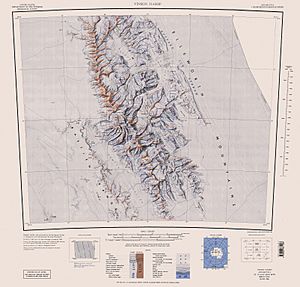Fukushima Peak facts for kids
Fukushima Peak is a tall, rocky mountain peak in Antarctica. It stands about 4,634 metres (15,203 ft) (or 15,203 feet) high! This impressive peak is found near the southern edge of the Vinson Plateau, which is a large, ice-covered area. It's part of the Sentinel Range within the Ellsworth Mountains.
This peak was officially named in 2006 by a group called the Advisory Committee on Antarctic Names. It was named after Eiichi Fukushima. He was an important member of an American expedition in 1966–67. This team was the first to successfully climb Mount Vinson, which is the very highest mountain in all of Antarctica! They also climbed other tall mountains in the Sentinel Range.
Where is Fukushima Peak?
Fukushima Peak is located in a very cold and remote part of Antarctica. Its exact spot is at 78°33′31″S, 85°34′16″W. This means it's in the southern part of the world, quite far west.
It's not far from other famous peaks in the area. For example, it's about 3.83 kilometres (2.38 mi) (or 2.38 miles) southeast of Mount Vinson. It's also close to Hollister Peak and Wahlstrom Peak. Maps of this area were first made by the United States in 1961 and then updated in 1988.
Exploring the Sentinel Range
The Sentinel Range is a major mountain range in the Ellsworth Mountains. It stretches for about 185 kilometres (115 mi) (115 miles) from north to south. It's about 48 kilometres (30 mi) (30 miles) wide. This range includes Mount Vinson, Antarctica's highest point, and many other tall peaks like Fukushima Peak.
The mountains here are mostly covered in ice and snow. However, some rocky peaks, like Fukushima Peak, stick out. These areas are very challenging to explore because of the extreme cold and harsh conditions.
Who was Eiichi Fukushima?
Eiichi Fukushima was a skilled mountaineer. He was part of the American Antarctic Mountaineering Expedition that made history in 1966–67. This expedition was a huge achievement because they were the first to reach the summit of Mount Vinson. Climbing Mount Vinson is a very difficult task, even for experienced climbers.
Naming a peak after him is a way to honor his important contributions to exploring and mapping Antarctica. It recognizes his courage and skill in climbing some of the world's most remote and challenging mountains.



